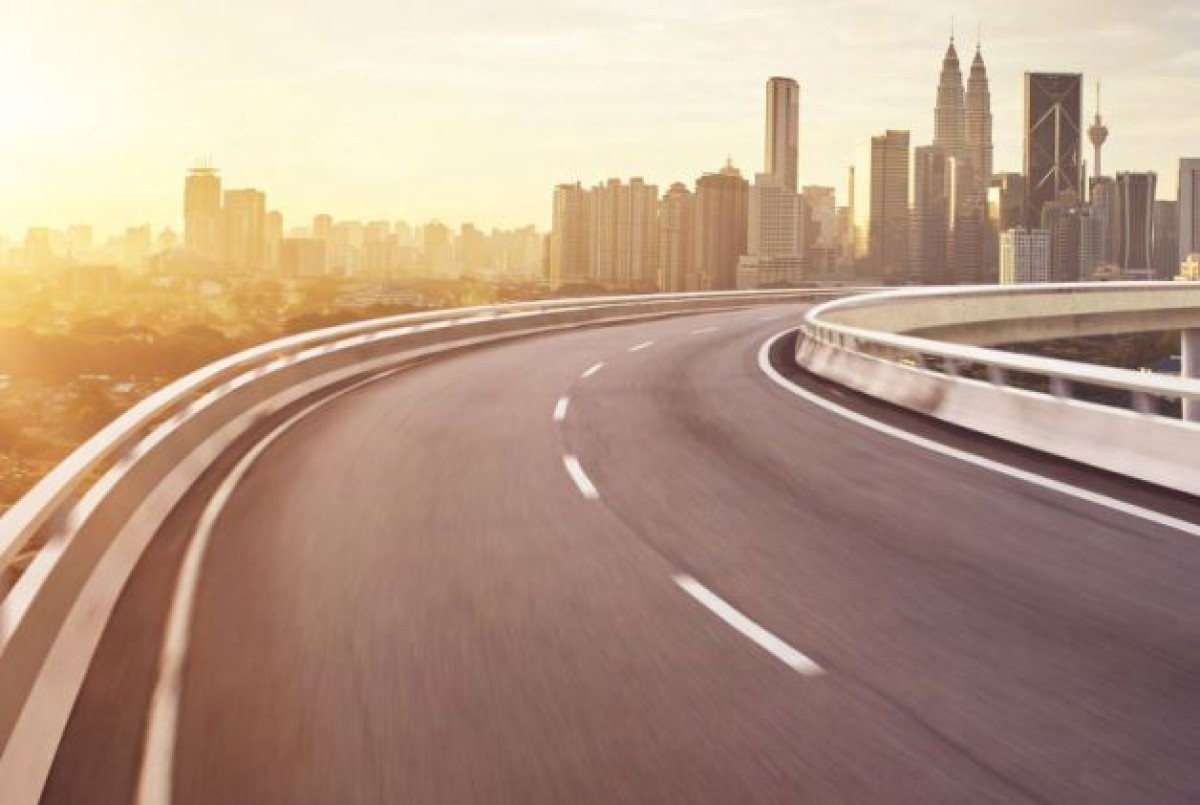The government aims to construct 23 new national highways by 2025!
India is expected to maintain current road construction momentum, adding up to 13,000 kilometers in the 12 months through March 2025, an annual increase of 5-8%, ICRA. India has the second-largest road network in the world, spanning a total of ~6.7 million kilometers (kms). This road network transports 64.5% of all goods in the country and 90% of India’s total passenger traffic uses the road network to commute. Road transportation has gradually increased over the years with improvement in connectivity between cities, towns and villages in the country.
In India, sales of automobiles and movement of freight by roads is growing at a rapid rate.
Market size
National highway construction in India increased at 5.3% CAGR between FY14-FY23. Despite pandemic and lockdown, India has constructed 10,457 km of highways in FY22. In FY23, the Ministry of Road Transport and Highways constructed national highways extending 10,331 kms. Under the Interim Budget 2024-25, the Government of India has allocated Rs. 2.78 lakh crore (US$ 33.46 billion) to the Ministry of Road Transport and Highways.National Highways Authority of India (NHAI) spent a record-breaking Rs. 2,07,000 crore (US$ 24.79 billion) on the construction of national highways in the fiscal year 2023-24. This was the highest capital expenditure ever recorded, representing a 20% increase from last year.
India’s road network has grown 59% to become the second largest in the world in the last ten years. India has nearly 66.71 lakh km of total road network and the National Highways network alone stood at 146,145 km in CY 2023.
India had a total of 97,830 km of National Highways in 2014-15 which has expanded to 146,145 km by December 2023. In FY24 approximately 12,300 kilometers of National Highways were constructed.
A total of 202 national highway projects worth Rs. 79,789 crore (US$ 9.59 billion) are at the implementation stage in the country and are 6,270 km in length.
The Road Ministry hopes to construct over 12,000 km of roads in FY24!
The Ministry of Road Transport and Highways expects to construct anywhere between 12,000 and 13,000 km of national highways in 2023- 24, which will be the second highest national highways construction in the country.
The highest annual construction so far has been 13,327 km in 2020-21 while the second highest was 10,855 km in 2018-19. The ministry has completed construction of 7,685 km till the end of January 2024. It had set a construction target of 13,814 km for FY ’24.“We are optimistic of doing 4500-5000 km in the remaining two months which will help us to achieve anywhere between 12,000 and 13,000 km in the current financial year. This will be the second best achievement,” road transport and highways secretary Anurag Jain.According to Jain, the current financial year will however see highest ever four-lane roads being constructed and highest ever speed or access controlled highways with capacity augmentation pegged at 9,500 km which will be a record for the ministry.“Up to January 2024, we have seen a 10% year-on-year growth while the increase in construction of four-lane highways is 16%,” he said, adding that the construction of four-lane and above roads now stands at twoand-a-half times the annual achievement of FY ’14.As per the government data, 794 km of six or eight-lane highways have been built in the country in the 10 months of the current fiscal between April and January 2024, compared to 753 km during the same period in 2022-23 and 715 km in 2021-22.The four-lang highways, on the other hand, have gone up to 2,503 km between April and January this year as against 2,093 km in 2022-23 and 1,684 km in 2021-22 while the construction of two-lane roads stood at 2,805 km vis-a-vis 2,331 km in 2022-23 and 2,269 km in 2021-22.The strengthening of national highways, however, has come down to 1,556 km in the April-January period of the ongoing fiscal compared to 1,625 km in 2022-23 and 2,016 km in 2021-22. “This is because strengthening of roads is a cyclical process and generally picks up every five years,” secretary Jain added.Jain added that the government is focussing on achieving zero maintenance complaints, zero arbitration and enhancing road safety by eliminating all black spots on the highways.“We hope to award all contracts for elimination of remaining 3,000 black spots in June when the model code of conduct is lifted and are actively finalizing the detailed project reports of all such projects,” he said.
Over 2 lakh km national highways to be built by 2037, length of high-speed roads to rise 10x
India will fast-track building of national highways including high-speed access-controlled highways to create a world-class road network by 2037 to enhance efficiency and reduce logistic costs as it seeks to become a developed nation by 2047, a senior government official said.According to the official, "The plan is to increase the national highways length to over 200,000 kilometers from 146,000 km now with over 10-fold jump in access-controlled highways to 50,000 km from 4,000 km over the next 13 years and reduce road accidents by 95% over the next 25 years. Under Vision 2047, the plan is to finish construction of requisite national highways by 2037 as good road infrastructure will play a crucial role and will have a multiplier effect in the following 10 years and will help India achieve the vision of a Viksit Bharat by 2047. The idea is to enhance logistics efficiency in the country to global standards through more accesscontrolled highways and high-speed corridors and the road transport and highways ministry is awaiting cabinet approval to kick-start work on new projects, in line with the Vision 2047. The ministry will see a major shift in strategy for road construction going forward, with upcoming big projects being constructed on the publicprivate-partnership mode, greater emphasis put on building best quality roads, and increasing focus on engineering aspects of road design to ensure the number of accidents are brought down significantly.India currently has 4,000 km of access-controlled high-speed highways while another 6,000 km is under construction.The total length of national highways currently stands at 1,46,145 km, which is 60% more than 91,287 km in 2015. India has about 6.67 million km of road network, including 179,535 km of state highways and 6,345,403 km of other roads.India witnessed 11.9% more accidents in 2022 at 4,61,312 compared to 2021 with the number of fatalities higher by 9.4% at 168,491 and number of injured persons up 15.3% at 443,366. The ministry has set a target of reducing road accidents by half by 2030.
Highway development in nationbuilding
The government’s vision is to elevate the Indian road network to global standards through extensive expansions and renovations. Highways play a critical role in the functioning of a country as they facilitate the connection between people, the transportation of goods, and other raw materials. India’s focus on highway development is a strategic move to ensure that the nation does not fall behind in infrastructure, which is essential for any country aspiring to develop. Significant investment in infrastructure is a prerequisite for economic growth, and as India positions itself as a global powerhouse, the capital allocated to infrastructure development lays the groundwork for a robust economy. The Bharatmala Pariyojana initiative underscores the central government’s belief in the power of a comprehensive network of roads, highways, and expressways to bolster India’s economy. With around 60% of India’s cargo movement relying on roads and highways, the expansion of this network is more vital than ever. This expansion is expected to reduce logistics costs from the current 16-18% of GDP to 10%, as per Nitin Gadkari, Union Minister for Road Transport and Highways. A more efficient road network will not only make India more competitive internationally but also boost exports.
State of highway development
A report by Bank of America Securities indicates that India is set to construct more national highways in the decade ending 2025 than it did cumulatively between 1950 and 2015. The highway construction sector is expected to see a remarkable 133% growth by 2025, outpacing any other country’s growth in recent times. Although India’s ambitious target of constructing 60 km of roads per day remains unmet, achieving an average of 30 km per day is already a significant milestone.However, the road ministry has expressed concerns to the Union Cabinet about the slowed pace of construction due to the reduced number of awards this financial year, which could affect future construction efforts. While this may not significantly impact the sector’s capital expenditure in FY25, the repercussions could be more pronounced in FY26. The economic downturn has adversely affected India’s highway construction programme, as highlighted by Policy Circle in November 2023. Diminishing government spending and challenges in securing new project financing have slowed progress. Additionally, the economic slowdown has curtailed private investment and, coupled with rising land acquisition costs, has hampered the pace of construction. The government is exploring ways to attract additional investment from market-collected funds and private sectors,considering the auctioning of completed highway projects, and seeking investments through foreign debt and bond markets.As India strives to maintain its economic growth momentum, it must give urgent attention to highway awards. With the Lok Sabha elections approaching, the government faces the challenge of awarding nearly 6,500 km of highway contracts in the next two months. Industry experts, however, remain hopeful for a resurgence in contract awards in the 2024-25 period, post-elections.
Let’s dive deep into the highlights of 2023 of the Road & Highways Network in India: Paving a Path to a Promising Future!
The GoI has given a massive push to infrastructure by allocating about $1.4 Tn for infrastructure to be invested until 2025. The market for roads and highways in India is projected to exhibit a CAGR of 36.16% during 2016-2025, on account of growing government initiatives to improve transportation infrastructure in the country. With a projected global infrastructure funding requirement of USD 3.7 trillion annually to keep pace with GDP growth, the significance of continued expansion and strengthening of India’s road network remains paramount. The highways sector in India has been at the forefront of performance and innovation. The government has successfully rolled out over 60 road projects in India worth over $10 Bn based on the Hybrid Annuity Model (HAM). HAM has balanced risk appropriately between private and public partners and boosted PPP activity in the sector. Asset recycling, through the toll-operatetransfer (ToT) model, has been taken up by the National Highways Authority of India (NHAI) for 100 highways. The first two bundles of 9 highways each were monetized successfully for an investment of over $2 Bn.NHAI has created a Guinness World Record by constructing 75 km continuous Single Lane Bituminous Concrete Road in record time of 105 hours 33 minutes, between Amravati and Akola on NH 53 in Maharashtra. NHAI along with Maha Metro achieved the Guinness World Record by constructing the longest Double Decker Viaduct (3.14 km) with Highway Flyover & Metro Rail supported on single column in between 3 metro stations in Nagpur.As one of the biggest reforms in the road transportation industry in India, the NHAI has gone ‘Fully Digital’, with the launch of a unique cloud-based and Artificial Intelligence-powered Big Data Analytics platform – Data Lake and Project Management Software. The entire project management work flow of NHAI is transformed from manual to online portal based, wherein the complete project execution operations including ‘workflow with time lines’ and ‘alert mechanism’ have been configured. All project documentation, contractual decisions and approvals are now being done through the portal only.
Construction of Four and Six Lane National Highway in the Country
The state-wise details of four/six lane works undertaken by National Highways of Authority (NHAI) are annexed. The projects in the NorthEastern States are generally taken up by the Ministry through its other executing agencies such as National Highways & Infrastructure Development Corporation Limited (NHIDCL), Border Roads Organization (BRO) and various State Public Works Departments (PWDs). In the State of Tripura, one work of around 25 km length with total capital cost of Rs. 2026 crore is under implementation by NHIDCL.The Ministry keeps on receiving proposals from various State Governments /UTs, for declaration / upgradation of State Roads, including State Highways (SHs), as new NHs. State roads, including State Highways (SHs), are declared as National Highways (NHs) from time to time on the basis of well-established principles. The important criteria for declaration of NHs include the following:
i. Roads running through the length / breadth of the country.
ii. Connecting adjacent countries, National Capitals with State Capitals / mutually the State Capitals, major ports, non-major ports, large industrial centers or tourist centers.
iii. Roads having important strategic requirements in hilly and isolated areas.
iv. Arterial roads which enable sizable reduction in travel distance and achieve substantial economic growth.
v. Roads which help in opening up large tracts of backward areas and hilly regions.
vi. Roads contributing towards the achievement of the National Highways grid of 100 km.
vii. Synergy with PM Gati Shakti National Master Plan (NMP)
NHAI’s several measures to modernize National Highways.
The road, transport and highways minister mentioned there is a whopping shoot up to near about 1.45 lakh km at present comparable to 91,000 km in India’s total National Highway network. The minister said NHAI is adopting several methods of monetization of national highways assets such as project based financing, ToT (toll-operate-transfer)and InVIT (Infrastructure Investment Trusts). Asset monetization plays a pivotal role in generating investment for infrastructure. NHAI is utilizing many innovative financing techniques and has created more than Rs 70,000 crore. Around Rs 34,000 crore has been generated through securitization via SPVs, Rs 26,000 crore is raised through ToT model and Rs 10,000 crore by NHAI InVIT (National Highways Infra Trust). With the conception of PM Gati Shakti National master plan and national infrastructure pipeline, the government has given an immense boost to the economy, the Union Minister added. The new infra projects which will come under these plans will help in connecting the remotest of India and will corroborate in integrated and overall development across the country by reducing time and cost.
National Highways Authority of India to build 5,060-km highway stretches in FY24
The National Highways Authority of India has set a target to construct highway stretches with a combined length of 5,060 kilometers in the current financial year, up from a record 4,882 km built last year.“The pace of construction increased by 13% in 2022-23. The target for this year has been set even higher,” a senior official said.Similarly, the NHAI aims to award highway projects of 6036 kilometers, up from 6003 km awarded in the previous financial year.In 2022-23, National Highways Authority of India (NHAI) also launched 167 projects with a total length of 5,213 km. In all, 55,000 km of roads are under various stages of execution, according to an ICRA report. In the first two months of this financial year, the NHAI has constructed 655.31 km of highways and awarded only one project of 22.42 km.In the first two months of this financial year, the NHAI has constructed 655.31 km of highways and awarded only one project of 22.42 km.Capital expenditure by the NHAI for the development of the national highway infrastructure touched an all-time high of Rs 1.74 trillion in FY23, significantly more than Rs 1.58 trillion provided by the government. The extra of around Rs 15,000 crore came from project-based financing.For this year, Rs 1.62 trillion has been set aside for the NHAI from the budget and the highway builder is aiming another Rs 15,000 to Rs 20,000 crore through private financing via special purpose vehicles for identified projects.Total capital expenditure of the ministry of road transport and highways has been kept at Rs 2.58 trillion for FY24, up from the Rs 2.06 trillion spent last year. Taken together with other models of financing highways apart from engineering, procurement and construction (EPC), where the NHAI spends all money, much more resources will be available for the highway construction this financial year. Other modes of highway construction are hybrid annuity model (HAM) and build operate transfer (BOT).In hybrid, concessionaires are paid by the NHAI in installments, and in BOT, private developer pays the cost of construction and recovers his investment through toll. Between 2007 and 2014, only BOT was used to build highways before it came to a grinding halt. In 2018-19 and 2019-20, no projects were awarded on BOT. Its share in total highway construction has gone down to less than 5% and the government wants to increase it to 10%. The EPC is expected to remain the mainstay of highway construction this year too with a total share of 70-75% of total awards, according to the ICRA report.
Indian roads will be better than roads in USA by 2024-end:
Transport Minister Nitin Gadkari The condition of the roads in India for the longest has not been up to par in terms of global competition, although in recent times the government of India has made some serious efforts to change this. The minister stated that the roads in India would be better than those in the United States of America by the end of 2024 under the Narendra Modi government. “We have decided that under the leadership of Prime Minister Narendra Modi, before the end of the year 2024, India’s road infrastructure will be better than that of America.”“American roads are not good because America is rich, but America is rich because American roads are good,” and said, “I’ve promised (UP CM) Yogi Ji that before the end of 2024, we’ll make the road infrastructure of Uttar Pradesh equivalent to that of the USA” He further stated that a total of Rs 5 lakh crore will be invested on roads in Uttar Pradesh before 2024. According to the minister, within two years in Uttar Pradesh, numerous projects will be completed. Some of the projects that he stated during IRC were 13 railway overbridges worth Rs 1,000 crore, the Shahabad bypass-Hardoi bypass for Rs 1,212 crore, the Shahjahanpur to Shahabad bypass worth Rs 950 crore, and a few others.Rising government initiatives towards better roads and highways infrastructure for freight and public transportation to drive India roads and highway sector through 2025.India has one of the largest road networks in the world, spanning over 5.8 million km. Of this, around 2% are National Highways, 3% are State Highways and the remaining belongs to district and rural road networks. Over 64.5% of all goods in the country are transported through roads, while 90% of the total passenger traffic uses the road network to commute.During the last five years there has been a significant growth in the road transportation network. The Government of India has allocated more than Rs 1.18 Lakh crore to the Ministry of Road Transport and Highways (MoRTH) as outlay for FY 2021-22. Further, the government has identified various economic corridors to play an enabling role in transforming India’s economy to grow to USD 5 trillion by 2025. Importance to the sector is also exhibited by the fact that it accounts for approximately 18% of the National Infrastructure Pipeline. Various state governments have also considered developing critical road corridors as a catalyst of economic development.
The Road Ahead
The Government, through a series of initiatives, is working on policies to attract significant investor interest. A total of 600+ sites are planned to be awarded by 2024-25 of which 144 Wayside Amenities (WSAs) have already been awarded. In the next five years, National Highway Authority of India (NHAI) will be able to generate Rs. 1 lakh crore (US$ 14.30 billion) annually from toll and other sources.
















Leave a comment